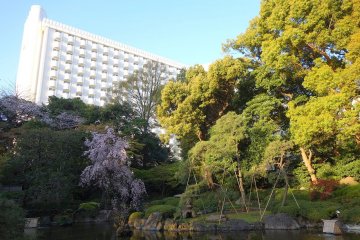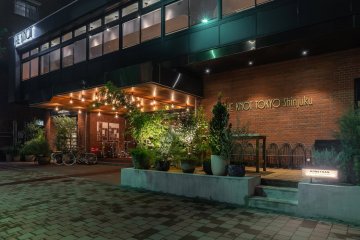
오모테산도의 네즈 미술관 & 정원
Tomoko Kamishima도쿄 네즈 미술관과 정원: 붓꽃의 계절과 녹음이 우거진 5월에 오가타 고린의 '붓꽃'과 스즈키 키이츠의 '산 개울' 특별전을 즐기세요!

The Nezu Museum, formerly known as the Nezu Institute of Fine Arts, is an art museum in the Minato district of Tokyo. The museum was established to preserve and exhibit the collection of premodern Japanese and East Asian art that Nezu Kaichiro (1860-1940) passionately built.
The Nezu Museum uses an online timed-entry reservation system, which is also ¥100 cheaper than buying at the door. You may not be able to enter the museum when it is crowded, so it is recommended to book a timed-entry ticket.
Opening hours for NEZUCAFÉ are 10am–4:30pm (last order for food @ 3pm / drinks @ 4pm).
After Kaichiro's death, his son and heir, Kaichiro Jr., established a foundation to preserve the collection in 1940 and opened the Nezu Museum in 1941 at its current location, where the Nezu family had previously lived. Much of it, including the galleries, garden, and tea house, was lost to a fire in 1945 during World War II, but the museum resumed exhibitions in 1946 with artwork that had been evacuated to a safer location during the war.
The museum's collection, which was quite extensive at the beginning with 4,642 works, was expanded to around 7,400 works. This includes seven national treasures, 87 important cultural assets and 94 important art objects.

도쿄 네즈 미술관과 정원: 붓꽃의 계절과 녹음이 우거진 5월에 오가타 고린의 '붓꽃'과 스즈키 키이츠의 '산 개울' 특별전을 즐기세요!

Just minutes from Shinagawa Station, the Grand Prince Hotel New Takanawa is surrounded by lush greenery in the Takanawa area, with rooms offering balcony views of the nearby gardens and the surrounding Tokyo cityscape. This urban resort features convention facilities like the Hiten banquet hall, the international Convention Center Pamir, as well as a wide variety of Japanese, Chinese and Western restaurants.

Located right next to Shinjuku Chuo Park, THE KNOT TOKYO Shinjuku is a modern hotel with an exceptional design and easy access to the nearby Shinjuku train station and the Meiji Shrine. The 14-story hotel building was renovated and reopened in August 2018 as THE KNOT TOKYO Shinjuku . The western-style rooms offer a park view on the top floor as well as a newly opened terrace suite. The spacious atrium design offers a relaxed atmosphere and connects the restaurant, bar, lounge and lobby with one another. One of the highlights of THE KNOT is the delicious dishes. There are six areas in which food and drinks are offered. From the grill area to high-quality black tea and fresh bread, everything is on offer.

ANA Holiday Inn Tokyo Bay (previously Dai-ichi Hotel Tokyo Seafort) is a 132-room hotel that will provide visitors to Japan’s capital city with an attractive, fresh option in the midscale space. ANA Holiday Inn Tokyo Bay will join a strong portfolio of 10 ANA Holiday Inn open and pipeline hotels across Japan, and become part of the brand’s global footprint of 1,234 open hotels and 278 pipeline properties.

If you're a fan of Quentin Tarantino’s Kill Bill, there's one Tokyo restaurant that absolutely deserves a spot on your bucket list. While you may not know it by its real name, chances are you've seen it on screen—it’s the unforgettable setting for the iconic, over-the-top showdown between The Bride and the Crazy 88. Known affectionately by fans as “The Kill Bill Restaurant,” this venue offers more than just cinematic nostalgia—it's a vibrant and unique dining experience in its own right. Located in Tokyo’s upscale Nishi-Azabu district, this classic-style izakaya bar is where fiction meets flavor. Though the fake blood and samurai swords have long been cleaned away, the spirit of the film lives on in the architecture and atmosphere. Stepping inside feels like walking onto the set: a grand, high-ceilinged hall with a central open-plan dining space, surrounded by a mezzanine-level balcony—instantly recognizable to anyone who’s watched the movie. But don’t mistake it for just a movie-themed attraction. The Kill Bill restaurant is a serious culinary destination. It offers a wide variety of traditional Japanese dishes, from sashimi and grilled skewers to noodle dishes and seasonal specialties. The menu also boasts creative fusion items like avocado and camembert tempura, which nods to the restaurant’s global popularity and mindset. And for international travelers with specific dietary needs, the restaurant provides vegan and halal-friendly menus (with at least three days’ notice). What makes this spot truly special is its ability to deliver a top-tier gourmet experience while doubling as a pop culture pilgrimage. You can sip sake where Uma Thurman once sliced through waves of enemies—minus the chaos, of course. Whether you’re a die-hard Tarantino fan, a foodie on the hunt for authentic Japanese flavors, or simply someone looking for a unique night out in Tokyo, this restaurant checks every box. Just one tip: Enjoy the drinks and dishes, but leave the swordplay to the professionals. Note: As you’d expect, Gonpachi is a popular restaurant. Same-day reservations are possible, but ideally you’ll want to reserve your table at least two days ahead of your visit, and even earlier if you’re planning to visit at the weekend.

B-Flat Commune is an open-air hangout in Omotesandō featuring a variety of stalls and food trucks offering unique drinks, clothing, and bites to eat. Its relaxed vibe and plenty of seating make it an ideal spot for casual meetups and spending time with friends. It's a creative place where people can gather to eat a the open-air dining space or purchase fashion, antiques, product goods and other lifestyle items. Events are sometimes hosted at this community space, and operating stores may change from month to month.

Mame Shiba Cafe offers a unique experience where you can interact with Shiba dogs while enjoying your favorite drinks. You cannot make reservations in advance through phone or online, so it is best to book early in the morning at a store. The cafe requires customers to make a reservation in-store, present their receipt at the reserved time, and then enter the cafe.

The National Art Center (NACT) is a unique and innovative art exhibition facility in Roppongi, Tokyo. It opened in 2007 and is located on a site previously used by a research facility at the University of Tokyo. The structure is one of the architect's last works Kisho Kurokawa. Instead of maintaining a permanent collection, the NACT uses its 14,000 square meter exhibition space, one of the largest in Japan, and focuses on serving as a venue for various art exhibitions. In addition, the public relations work is supported by various educational programs. The art library, which can also be found there, serves to collect and disseminate information about art.

Roppongi Hills is one of the largest real estate complexes in Japan, based in Roppongi, Minato-ku. The building complex designed by Minoru Mori and opened in 2003 consists of offices, stylish apartments, shops, restaurants, cinemas, a museum, an art gallery, a hotel, a TV studio, an outdoor amphitheater and a few parks, the office floors house leading companies in the IT and financial sectors, making Roppongi Hills a symbol of the Japanese IT industry. In the center of Roppongi Hills is the 238-meter-high Mori Tower, one of the tallest buildings in the city. On the top floors there is an observation deck that offers a beautiful view of Tokyo and a modern art museum focusing on new artistic ideas from around the world. There are numerous shopping opportunities throughout the complex and there is also a large Toho Cinemas cinema showing both Japanese and international films.

The Mori Art Museum in Roppongi has set itself the goal of being a place of fun, stimulation and discussion - a place where what is important in culture and society is openly discussed. Not only through the exhibitions that are shown there, but also through a wide range of educational programs. It appeals to an audience that ranges from young schoolchildren to college students and seniors, from people who live in regional society to all over the world. The operators of the museum also consider it their task to create a platform for the artists from the region. Since opening, the museum has received high critical acclaim for its wide variety of unique exhibitions, many of which are centered on cosmopolitan themes.